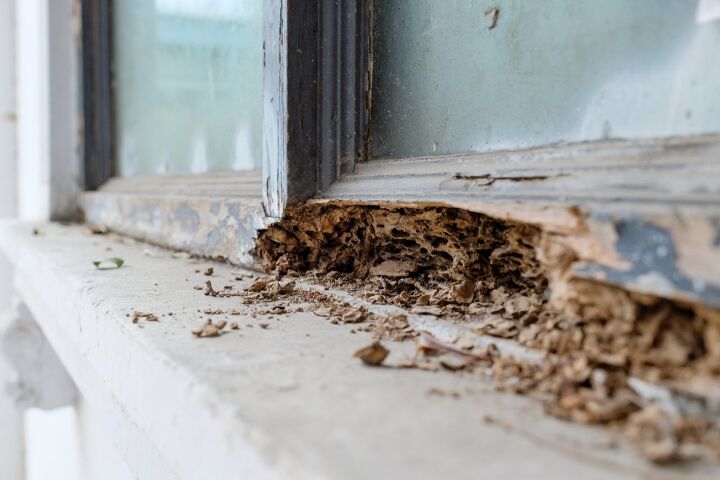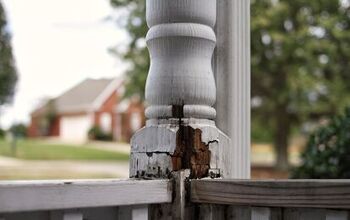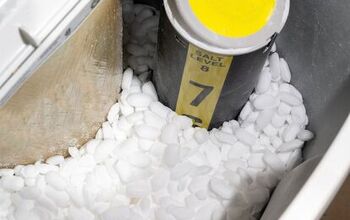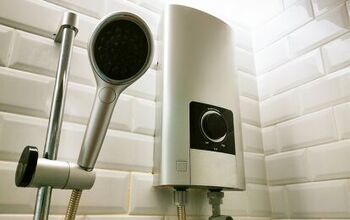Termite Damage Vs. Water Damage: What Are The Major Differences?
Did you just notice holes or dark patches in the wood of your home? Maybe your mind goes right to water damage. And while wood rot is a possible cause of these symptoms, it’s not the only possibility. There is a chance you might also have a termite infestation. So how will you know if your home has water damage or termite damage?
Water damage is caused by moisture buildup within the home. The affected wood may become darkened, spongy, or moldy. Termite damage is caused by a termite infestation within your walls, floors, or foundation. The wood may be grooved and muddy or crumbling. Termites leave behind wings or droppings. Both should be promptly treated by a professional.
It can be difficult to tell the difference between termite damage and water damage. In instances where wood appears darkened, swollen, or chipping, it could be either case. Regardless, seeking a professional to diagnose the issue is your best bet. Termites and water damage alike can begin months or years before you notice anything.
Do You Need Pest Control Services?
Get free, zero-commitment quotes from pro contractors near you.

What is a Termite Infestation?
No one wants to have a termite infestation. These pests are small, hard to exterminate, and hide very well behind walls and under flooring. While termites can’t eat through cement, they find other ways in. Termites can burrow into the house through cracks in your home’s foundation. They also commonly get in from places where wood meets the ground, like porches, door frames, or garage trimming.
There are two common types of termites to be aware of:
- Subterranean termites. These hardier termites are harder to kill than dry wood termites. They burrow down into the wood or soil of your home’s foundation. Finding a way inside through foundational cracks or mud tunnels, they can bring down entire buildings by nesting in the foundation. If you suspect you have these, call a professional immediately.
- Drywood termites. These larger termites are less common, but easier to kill. They also don’t require as much moisture or soil to live, so they stake out exclusively inside wood. This unfortunately makes them less visible than the subterraneans’ larger nests.
People often think that termites start by eating the outside of the wood, and work their way in. The opposite is actually the case. Termites will live inside the wood, and eat from the inside to the outside. This means a termite infestation could be happening for months or even years before you recognize it.
Signs of Termite Damage
To distinguish termite damage from water damage, it’s important to know the signs of termites. It can be confusing to tell the difference, because termites are drawn to wet wood in your home. So early stages of water damage might actually attract them to that location..
Here are some signature features of termite damage in your home:
- Hollowed out grooves that follow the wood grain. Termites usually burrow out little highways that look like grooves following the wood grain. These grooves are often covered in mud. This is the most distinct visual sign of termites.
- Splintering, crumbling, or swollen wood. Does the ceiling or floor look swollen? Is it splintering with little holes, or is the paint crumbling or chipping? These are signs termites are dwelling within.
- Frass droppings. Frass is a wood-colored termite dropping. These are left behind by drywood termites as they eat through a wooden structure. Common places to spot frass include door frames, baseboards, and deck perimeters.
- Mud tunnels around the foundation. Subterranean termites burrow tunnels into the mud around a home’s foundation. Their nests require a lot of moisture, so they seek out very wet soil and wood.
- Wood that sounds hollow. Knock on any wood that looks off to you. If it sounds hollow inside, termites may be feasting within the structure.
What is Water Damage?
Water damage is something most of us are all too familiar with. Water damage happens when excess water makes its way into spaces and materials, keeping them damp. This excess water gets absorbed by wood, walls, or fabrics and can cause erosion, mold, or stains. Common causes of water damage are broken pipes, leaky roofs, flooding, or condensation.
Wood rot is when moisture gets absorbed by wood, and it remains damp. This creates the prime conditions for fungi to grow, causing mold, mildew, and slow decay of the wood.
Signs You Have Wood Rot
Wood rot and termite damage can look similar. Like termites, wood rot can cause splintering or crumbling wood, as well as a spongy or swollen texture. Here are some tell-tale signs of wood rot or water damage:
- Flaking, crumbling, or warped wood. This sign of water damage can look similar to termite damage. Wood rot can cause the paint to flake, or the wood to feel dry and crumbly. It can also create a warped appearance on walls or floorboards.
- Musty, damp, rotten smell. When wood rots, it often emits a musty smell. That’s because mold, mildew and fungus grow in the damp environments of wet wood. If you smell a rotten scent from any wood structure, contact a professional. The presence of mold is damaging to your home and health.
- Areas that are darker than nearby wood. Another sign of water damage that may look similar to termite damage is discolored wood. If one area of the wood looks darker than the wood around it, you may have water damage.
- Spongy texture. Is the wood swollen, soft and spongy? This is a common sign of wood decay.
- Pools of water or falling droplets. If there is a mysterious pool of water on the floor, or droplets falling from the ceiling, you may have water damage. Roof leaks can let in water that seeps through the ceiling.
If you suspect wood rot in your home, contact professional help immediately. Water damage can cause permanent destruction of items in your home, or even structural collapse.
Differences Between Termite Damage and Water Damage
Termite damage and wood rot can have similar characteristics. This often makes it difficult to tell the difference. But there are a few signs that can help you distinguish between the two. And keep in mind, if you’re stumped you should consult a professional to inspect the damage. Here are some key differences between termite damage and water damage:
- Wood rot feels spongy and stringy and breaks off in cubes or long strands. Termite damage often happens on the inside. It isn’t always visible from the outside.
- Wood rot causes wood to darken in certain areas, whereas termite damage makes the wood look hollowed out, or with long grooves that follow the grain.
- Wood rot won’t cause a hollow sound in the wood when knocked on, whereas termite damage can make the wood sound hollow when tapped.
How to Prevent Termite Infestations
It’s best to focus on preventing termites from getting into your home in the first place. They are very hard to exterminate and can wreak havoc before you ever notice them. The presence of termites almost always requires a professional exterminator.
So how can you nip these pests in the bud before they can burrow their way inside? Here are ways to prevent termite infestations:
- Fix water leaks right away. Termites thrive in moist wood environments. It’s best to catch any water damage early before it can worsen and attract the insects.
- Maintain proper drainage around your house foundation. Subterranean termites build their nests in moist soil around home foundations. They require plenty of moisture to survive and tunnel. Make it more difficult for them by ensuring your ground soil stays relatively dry and properly drained.
- Fill in the cracks in your foundation. Termites also enter your home through cracks in the cement foundation. They will also enter through any openings where utility pipes enter your home, or crevices in your garage doors. Inspect your foundation for any compromised openings and fill them in.
- Apply a termiticide treatment around your foundation. A powerful way to prevent subterranean termites is to apply a termite chemical treatment as a barrier around your home’s foundation. You should also treat your house for termites regularly.
Do You Need Pest Control Services?
Get free, zero-commitment quotes from pro contractors near you.

Related Questions
How do you kill termites?
A professional grade termiticide is most effective at killing termites. Termite baits can also be installed around the house perimeter. As a DIY option, you can spray a mixture of water, dish soap, and orange or neem oil onto the infested wood.
Is water damage covered by insurance?
Under most standard home insurance policies, water damage is covered when it is “sudden or accidental.” Unexpected events within the home such as burst pipes are typically covered. But exterior events such as sudden storms and flooding are usually not covered. Water damage that’s slowly caused over a long period of time usually isn’t covered either. An example of this might include a leaky sink faucet.
What do termites leave behind?
Termites leave behind frass, which is pellet-shaped termite excrement. It is composed of wood waste as the termites eat, making it easy to mistake for sawdust. Frass is usually left near the nest. Drywood termites tend to leave behind visible excrement, whereas subterranean termites leave droppings within the wood, making them less noticeable. Termites may also leave behind their shed wings.
More by Jessica Vaillancourt



























